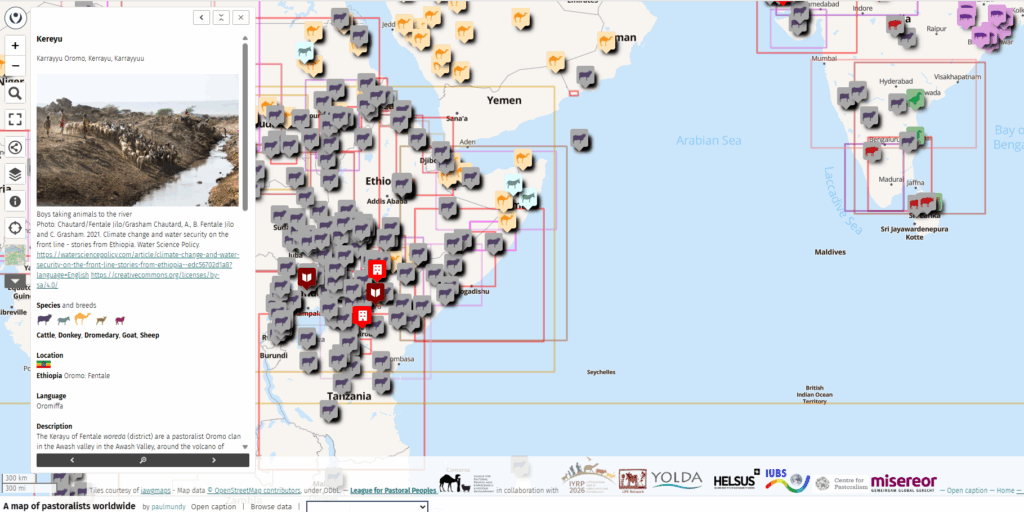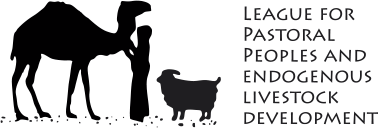https://www.pastoralpeoples.org/pastoralist-map/

Map information
Select the About icon ![]() in the menu on the left side of the map screen for a popup with a short description of the map and its contents.
in the menu on the left side of the map screen for a popup with a short description of the map and its contents.
Scroll down to the bottom of this popup and click on Credits for licensing information.
Pastoralist groups
A pastoralist group (represented by the animal map pins) is a community that manages domesticated animals in a pastoralist system (one where the animals walk to their feed). They may be a particular ethnic group or caste, have a specific cultural identity and traditions, use a particular management system, raise specific species or breeds, or occupy a particular region.
The boundaries of pastoralism are fuzzy. But we exclude livestock farming (where animals are kept in fields or enclosures) and intensive livestock raising (where they are kept indoors).
Some groups are very large, or range over large territories (Bedouin, Fulbe, Somali, Touareg, Great Plains ranchers) and include subgroups. Where information is available, both the larger group and its subgroups are shown on the map.
We do not include individual projects or initiatives. But if several such initiatives exist, we can include them as a “pastoralist group”. Examples are Wilde Weiden in Europe (see the map pin on the Germany/Denmark border) and the Urban shepherds (the map pin on Paris).
Definitions of pastoralism
The following definitions are used by the International Year for Rangelands and Pastoralism:
- Pastoralism: A land-use and livestock-production system in which the animals are grazed and watered using primarily natural resources (Kelly et al. 2024).
- Pastoralists: People who gain their livelihoods primarily from livestock (domesticated and semi-domesticated animals) that graze predominantly on natural or seminatural rangelands including grasslands (Kelly et al. 2024).
- Rangelands: Land on which the indigenous vegetation (climax or sub-climax) is predominantly grasses, grass-like plants, forbs or shrubs that are grazed or have the potential to be grazed, and which is used as a natural ecosystem for the production of grazing livestock and wildlife (Allen 2011).
Layers in the map
The map features are placed on a series of layers. To show or hide layers click on the Open browser icon ![]() in the menu on the left side of the screen.
in the menu on the left side of the screen.
Map pins on one layer may hide pins on the layers beneath. A pastoralist group that keeps cattle, goats and sheep has three map pins, one on the layer for each species. To show just one layer, hide all the layers then show the layer you want.
There are layers for:
- Livestock species (the animal icons): These show pastoralist groups that keep the various species (one layer for each species);
 alpaca
alpaca Bactrian camel
Bactrian camel bison
bison buffalo
buffalo cattle
cattle donkey
donkey dog
dog dromedary
dromedary duck
duck goat
goat horse
horse llama
llama pig
pig reindeer
reindeer sheep
sheep yak.
yak.
- Organizations (the red building icons):
 These show organizations relating to pastoralism.
These show organizations relating to pastoralism. - Countries (the brown book icons):
 These point to information briefs in the League for Pastoral Peoples’ Accounting for Pastoralists series.
These point to information briefs in the League for Pastoral Peoples’ Accounting for Pastoralists series. - Migration patterns (the red and brown rectangles).

- Species ranges (these are hidden by default); alpaca, Bactrian, wild Bactrian, buffalo, caribou, cattle, dromedary, guanaco (actual and natural), llama, reindeer, vicuna, yak.

Location of map pins
The locations of the map pins for the pastoralist groups are indicative only. They are placed in the general area where the group is based, not at a specific address. This means that if you zoom in, the pin may point to an inappropriate location (such as an urban area or water body).
We realize that this is not ideal, but it seems better than the alternatives. For the vast majority of groups we do not have enough information to give a more accurate location. Drawing a circle or polygon to show the area used by a group would be misleading: it would give a wrong impression of accuracy and might lead to disputes over who has rights to what area.
As far as possible, the map pins for organizations are located at that organization’s contact address.
Base map
It is possible to change the base map. Click on More controls (the down arrow) ![]() in the menu on the left side of the screen to select a different background map or satellite image.
in the menu on the left side of the screen to select a different background map or satellite image.
Sources of information
The items on the map were identified in various ways.
- Literature searches for pastoralism in particular countries or regions.
- Lists of ethnic groups and pastoralist groups (e.g., www.101lasttribes.com, reindeerherding.org, and wikipedia.org/wiki/Pastoral_society.
- Submissions by other researchers.
The descriptions in the pop-up boxes are based on various types of sources.
- Scientific literature. This is the preferred source. But such information is often lacking or hidden behind a paywall.
- News articles.
- Organizational websites, such as UN and government agencies and NGOs.
- Cooking and travel websites.
- Personal communication.
Breeds
Where we have the information, we have included information on breeds in the pop-up boxes of each pastoralist group.
Pastoralist organizations
An organization (represented by the red office map pins) ![]() is an organization related to pastoralism. Its members may be pastoralists themselves (a pastoralist organization) or people who support pastoralism but who do not practise pastoralism themselves (a pastoralist support organization).
is an organization related to pastoralism. Its members may be pastoralists themselves (a pastoralist organization) or people who support pastoralism but who do not practise pastoralism themselves (a pastoralist support organization).
An organization usually has an address and contact details and perhaps a logo and website.
We have not so far focused on the organizations layer of the map.
Migration patterns
Migration patterns are shown as red or brown rectangles. ![]() Click on the edge of the rectangle to get a pop-up box; click on the map in the box for a larger version of the map.
Click on the edge of the rectangle to get a pop-up box; click on the map in the box for a larger version of the map.
These maps generally show three types of movements:
- Seasonal migrations, such as between wet- and dry-season grazing areas or summer and winter pastures.
- Marketing routes: routes used to bring livestock to market.
- Crisis routes: directions followed during a crisis such as a drought.
Some of these movements follow fixed routes, such as cañadas (Spain), drailles (France), tratturi (Italy), travelling stock routes (Australia) and livestock corridors (parts of Africa). Others are less well defined. Many migration patterns appear as general directional arrows rather than as specific routes.
A few of the maps on this layer show grazing areas rather than (or as well as) arrows.
Types of pastoral systems
We are planning to include the types of pastoralist management system used by each of the groups. The categories are: Nomadic, Semi-nomadic, Sedentary, Vertical transhumant, Horizontal transhumant, Agropastoralist, Rancher, Other, Unclear.
This has certain limitations:
- Lack of information. For many groups we do not have enough information available to determine the type of management system.
- Multiple management systems used. Pastoralists are (and have to be) very flexible. They may practise several different management systems simultaneously. For example, part of their herd may be nomadic, while another part remains in a particular location (sedentary). Some members of a group may practise one system, while others use another. A pastoralist household may switch from one system to another depending on the situation: transhumant this year, sedentary next year.
- Categorization of management systems. As with the definition of pastoralism itself, it is difficult to draw clear boundaries between different types of management systems. There is considerable overlap between semi-nomadic, transhumant and agropastoralist, for example.
For these reasons, a group may be classified as practising more than one type of management system, or their system may be marked as Other or Unclear.
Possible new layers
Below are additional layers that are under consideration.
Background layers
- Land uses, vegetation types
- Climate, elevation
- Distribution of livestock species
Foreground layers
- Pastoralists’ problems
- Management systems (nomadic, semi-nomadic, sedentary, transhumant, agropastoralist, ranching…)
- Laws relating to pastoralism
- Historical migration patterns
- Videos on pastoralism
- Projects on pastoralism
Mapping software
The map is on the League for Pastoral Peoples’ website at https://www.pastoralpeoples.org/pastoralist-map/.
The map uses the uMap mapping tool https://umap-project.org/, which in turn uses OpenStreetMap’s background layers.
The map data is held in an Airtable database https://airtable.com/. The data is transferred manually into uMap using CSV (for most of the layers or GeoJSON (for the migration patterns).
Using the map
The map is available under a Creative Commons Attribution 4.0 International (CC BY 4.0) license (see the Credits section at the bottom of the About panel ![]() in the map for details). The photo credits are beneath each photograph.
in the map for details). The photo credits are beneath each photograph.
You can embed the map in your own website using this link: http://u.osmfr.org/m/563977/
To share or download the dataset, go to Share and download in the menu on the left.
The webpage https://www.pastoralpeoples.org/pastoralist-map/ has several posters based on the map that are free to download.
Contact paul@mamud.com for an API.
